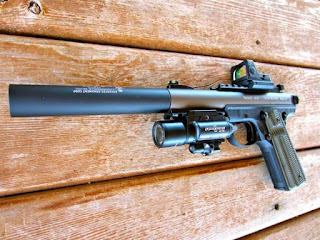Regular readers will know that Friday blogs tend to be a little more off-topic than usual. They will also know that I play the occasional video game and that sometimes these inspire eccentric trains of thought.
Recently I was playing a scenario where I had to infiltrate disguised as a civilian. The game let you arm yourself with any of the weapons you had unlocked, however. The game makes you use full-automatic fire when the weapon has the capability so my “covert” weapon was a Mk48 GPMG! This got me thinking about what would actually be practical in the real world.
One option is a compact submachine gun. A problem with these is that while there are a number of models with small dimensions even these can be surprisingly massive. Very few of them are less than six pounds. The main exception that springs to mind is the Czechoslovakian Škorpion, but this is somewhat underpowered. A few of the more recent designs like the Steyr TMP/ Brügger & Thomet MP9 are under six pounds. Machine pistols have other undesirable features. Most fire from an open bolt and the movement of a relatively massive component does not facilitate accurate fire, even when firing semi-automatically. Most designs are single action, requiring a safety to be disengaged or the weapon to be cocked before firing. Not idea for a covert weapon that may be needed at very short notice!
The usual alternative to machine pistols are handguns. The main problem with handguns in this role is accuracy.
A real world attempt at solving these problems was the Soviet APB aka APSB weapon. I first saw one of these back in the 1980s in a magazine. It had been taken from a German “lorry driver”. The APB/ APSB is a modified Stechkin APS pistol. The most notable feature is the modifications made for use with a suppressor. In most weapons 9x18mm ammunition is subsonic. The longer barrel of the Stechkin took velocity up to the transonic range. Cold weather might also lower the speed of sound to levels where any shots might break the sound barrier. To prevent this the APB had a port drilled in the barrel and bled-off gases were diverted forward into the suppressor. Like the APS the APB can be fitted with a shoulder stock. This increases the accuracy of the pistol and is probably the main reason the APS was chosen as the basis of a covert weapon system. The stock also improves control when the APB or APS is used for fully automatic fire. I suspect, however, that the main intention of the APB was to provide an agent with a compact means of accurate, suppressed fire.
The APB was an good answer to the problem of covert/ clandestine armament. The TV show “Man from UNCLE” seem to have reached a similar conclusion, although their “Specials” often mounted an extended barrel rather than or as well as a suppressor.
Vietnam-era SEAL “Hush Puppy”. US army was using subsonic .45 ammunition as its standard pistol round. North Vietnam was using subsonic 9x18mm Makarov ammunition. Hush Puppy was based on a weapon that used supersonic 9x19mm Luger ammunition so needed special subsonic loadings….
If we update this concept the first decision is a suitable weapon, or more specifically a suitable calibre. On another blog I explain that the only logical choice for a military pistol calibre is the 45 ACP. It is a proven effective combat round and it is subsonic, facilitating use with suppressed weapons. All other likely choices are either underpowered or supersonic.
Back in the late 80s and early 90s the US special forces began shopping for an “Offensive Handgun Weapon System” (OHWS). The weapon selected became the Mk23. Logically enough, it was a .45 ACP. The barrel of this weapon was a shade under 6” long. The motivation for that feature may have been to surpass the Colt Govt model that this weapon would inevitably be compared with. A friend of mine got to try out some of the early Mk23s on a shooting range. The extra barrel length caused many of the standard .45 loads he was trying to go supersonic. This drew considerable attention from other shooters. It was not, however, an ideal feature for a weapon that was intended to be used with a suppressor!
Any pistol used for a “Covert Offensive Weapon System” (COWS (I truly suck at naming things!)) should have a barrel length consistent with keeping bullet velocity subsonic under likely temperature ranges. A feature of the OHWS worth emulating is its flashlight/ Laser Aiming Module. As an intended primary weapon system it would be useful for the COWS to have a source of visible and infra-red illumination. A visibly aiming laser can be useful for intimidating an enemy and encouraging them to surrender. It can also be used to designate points of interest or potential threats. An IR laser may be the most practical way to aim the weapon when using night vision goggles.
The role of the COWS will be to provide accurate, suppressed semi-automatic fire.
The Books
The most obvious difference between systems such as the OHWS and the COWS would be the provision of a shoulder stock to facilitate accurate shooting. Some readers will be aware that shoulder-stocked Mauser pistols were a very practical alternative to conventional rifles in the early part of the previous century. An updated design of pistol stock might be telescopic or folding. Unlike some current commercial offerings it would attach to the weapon, not the magazine.
To use a pistol stock the weak hand can be used to support the butt. This is similar to the way you would fire a bipod-mounted rifle or machine gun. A variation is to place the weak-side arm under the stock and place the weak-hand on the strong-arm forearm or biceps.
UNCLE wisely provided their agents with a small optic scope. Accuracy is often improved by a better sight picture. A reflex sight would improve the effective accuracy of the weapon system.
A foregrip for the COWS may also improve effective accuracy. An interesting option is to use a spare magazine as a grip. A dedicated design of grip offers a good location to mount the flashlight and laser systems. It may still be possible to use the forward pistol grip to store a spare magazine. A foregrip that mounts under the barrel could also be used as the mounting point for a telescopic or folding stock. Mounting such a grip would immediately convert a pistol into a COWS.
COWS is essentially a collection of
accessories. A suppressor, a reflex sight and a foregrip/ stock. This means it
can be used with existing weapons rather than having to go through the
prolonged process that often accompanies the adoption of a new weapon.
So far, I’ve not seen a flashlight/ laser/ foregrip that also mounts the stock. If you saw the movie “John Wick” or the Bond film “Spectre” you may have noticed the KPOS carbine conversion for Glock pistols. Not quite as elegant as the one-piece COWS grip I suggest, but along the right lines. The Belgium VBR-B PDW would serve as a COWS if it was available in .45 ACP calibre.
The Books







































